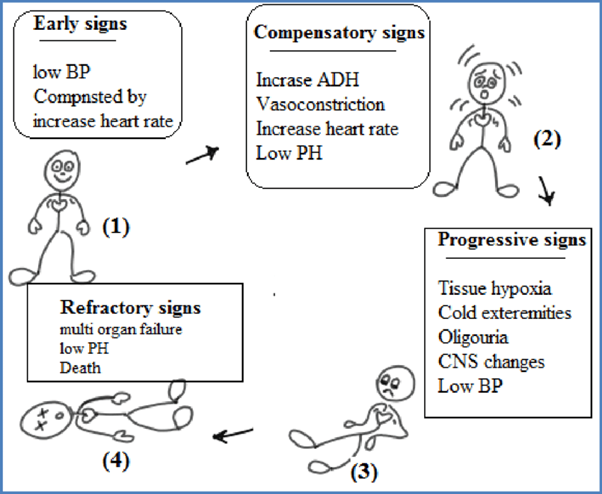A patient who has been involved in a motor vehicle crash arrives in the emergency department (ED) with cool, clammy skin; tachycardia; and hypotension. ordered by the health care provider should the nurse implement first?
Insert two large-bore IV catheters.
Provide oxygen at 100% per non-rebreather mask.
Draw blood to type and crossmatch for transfusions. Initiate continuous
electrocardiogram (ECG) monitoring.
The Correct Answer is B
Cool, clammy skin, tachycardia, and hypotension are signs of shock, indicating inadequate tissue perfusion and oxygenation. The immediate priority is to ensure adequate oxygen delivery to the tissues. Providing oxygen at 100% via a non-rebreather mask helps increase the patient's oxygen saturation and improve tissue oxygenation.
While all the options mentioned are important in the management of a patient in shock, oxygenation takes priority as it directly addresses compromised tissue perfusion and oxygenation.
A. Inserting two large-bore IV catheters in (option A) is incorrect because: Establishing intravenous access is crucial for fluid resuscitation and administration of medications, but it can be done after ensuring adequate oxygenation.
C. Drawing blood to type and crossmatch for transfusions in (option C) is incorrect because Blood typing and crossmatching are important for potential blood transfusions but should not be the first action in this critical situation.
D. Initiating continuous electrocardiogram (ECG) monitoring in (option D) is incorrect because Continuous ECG monitoring is important for assessing cardiac rhythm and detecting any dysrhythmias, but ensuring oxygenation should be the initial priority.
Therefore, in a patient presenting with cool, clammy skin, tachycardia, and hypotension, the nurse should first provide oxygen at 100% via a non-rebreather mask to address inadequate tissue perfusion and oxygenation.
Nursing Test Bank
Naxlex Comprehensive Predictor Exams
Related Questions
Correct Answer is D
Explanation
Arterial pressure monitoring involves the insertion of an arterial catheter, typically in the radial artery, to directly measure blood pressure. Complications can arise from this invasive procedure, and one potential complication is inadequate blood flow to the hand, leading to numbness or ischemia.
A. The Allen's test is positive in (option A) is incorrect because The Allen's test is performed before arterial catheter insertion to assess the collateral circulation of the hand. A positive Allen test indicates adequate collateral circulation, which is desirable before performing the procedure. However, it does not directly indicate a complication during or after arterial pressure monitoring.
B. The mean arterial pressure (MAP) is 90 mm Hg in (option B) is incorrect because The mean arterial pressure (MAP) represents the average pressure in the arterial system during one cardiac cycle. While changes in MAP can be significant for patient management, it does not specifically indicate a complication of arterial pressure monitoring.
C. The dicrotic notch visible in the waveform in (option C) is incorrect because The dicrotic notch represents the closure of the aortic valve and is a normal finding in arterial waveforms. Its presence does not indicate a complication.
Correct Answer is A
Explanation
The stages of shock are commonly described as the initial, compensatory, progressive, and refractory stages. Here is an explanation of each stage and why the patient's assessment findings correspond to the progressive stage:
B. The compensatory stage in (option B) is incorrect because, In the compensatory stage, the body continues to activate compensatory mechanisms to maintain perfusion. This includes increased heart rate, peripheral vasoconstriction, and shunting of blood to vital organs. The patient's assessment findings of decreasing cardiac output, decreased peripheral perfusion, and increased capillary permeability suggest that the body's compensatory mechanisms are no longer sufficient to maintain perfusion adequately. Therefore, the patient has progressed beyond the compensatory stage.
C. The initial stage in (option C) is incorrect because, In the initial stage, there is an initial insult or injury that triggers the shock state. The body's compensatory mechanisms are activated, such as increased heart rate and vasoconstriction, to maintain blood pressure and perfusion. However, the patient's assessment findings indicate that they have progressed beyond the initial stage.
D. The refractory stage in (option D) is incorrect because The refractory stage represents a severe and irreversible state of shock where vital organs fail, and despite interventions, the patient's condition does not improve. The patient's assessment findings do not suggest the refractory stage, as there is still potential for intervention and management.

Whether you are a student looking to ace your exams or a practicing nurse seeking to enhance your expertise , our nursing education contents will empower you with the confidence and competence to make a difference in the lives of patients and become a respected leader in the healthcare field.
Visit Naxlex, invest in your future and unlock endless possibilities with our unparalleled nursing education contents today
Report Wrong Answer on the Current Question
Do you disagree with the answer? If yes, what is your expected answer? Explain.
Kindly be descriptive with the issue you are facing.
